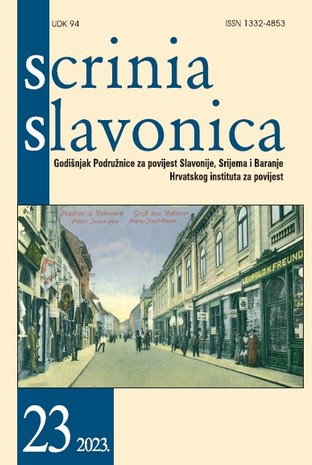Ustroj i djelovanje Dioničarskog društva sjedinjenih podravsko-posavskih vicinalnih željeznica
The structure and the activity of United Podravina-Posavina Vicinal Railway Ltd
Author(s): Ivica Halapir, Siniša LajnertContributor(s): Marijan Bosnar (Translator)
Subject(s): Economic history, Pre-WW I & WW I (1900 -1919), Interwar Period (1920 - 1939), Transport / Logistics
Published by: Hrvatski institut za povijest
Keywords: United Podravina-Posavina Vicinal Railway Ltd. in Budapest/Zagreb/Belgrade; vicinal (local) railways; privately owned railways exploited by the state; repurchase and nationalisation;
Summary/Abstract: In the paper the authors outline from the aspect of the history of institutions the structure and the activity of the United Podravina-Posavina Vicinal Railway Ltd from its establishment in 1906 with the fusion of the Local Vinkovci-Županja-Sava Coast-line Railway Ltd and the Osijek-Đakovo-Vrpolje Vicinal Railway Ltd, to 1940 when it was officially liquidated. The ownership of its railway tracks was taken over by its legal successor, the United Podravina-Posavina Vicinal Railway Ltd. From the former it took over the Vinkovci-Županja-Sava Coastline railway line (put in service on 30 September 1901) and from the latter the Osijek-Đakovo-Vrpolje railway line (put in service on 11 September 1905), as well as its supplementary part – the Osijek-Drava Coastline freight gauge (put in service on 15 May 1907). The newly established company built just a single railway line i.e. Osijek-Vinkovci (put in service on 24 November 1910). The company’s headquarters during the Austro-Hungarian Mon-archy was, like for the majority of vicinal railways, in Budapest. The stock company’s tasks were performed by: the stockholders’ general assembly, headquarters and the inspecting committee. The company’s railway lines were exploited i.e. administrated by the state. At first they were under the jurisdiction of the Traffic Administration of the Royal Hungarian State Railways in Szeged, whereas from 1915 to 1918 they came under the jurisdiction of the newly established Traffic Administration in Pecs. During the Austro-Hungarian Monarchy the company gained profit and that fact made it one the more profitable privately owned vicinal railways in the territory of the Kingdom of Croatia-Slavonia. In the Kingdom of Serbs, Croats and Slovenes the company first transferred is headquarters to Zagreb and later on to Belgrade. From 1918 the company’s railway lines were exploited by the Directorate of the State Rail-ways in Zagreb. In 1923 the Osijek-Strizivojna Vrpolje, the Osijek-Vinkovci and the Vinkovci-Županja-Sava Coastline railway lines came under the jurisdiction of the Directorate of the State Railways in Subotica, while the Osijek-Drava Coastline rail-way line remained under the administration of the Directorate of the State Railways in Zagreb. In 1928 the Osijek-Strizivojna Vrpolje railway line was returned to the Directorate of the State Railways in Zagreb. The Kingdom of Yugoslavia started to repurchase the privately owned vicinal railways which after long negotiations resulted in the concluded treaty on the repurchase with the group of 24 Hungarian vicinal railway Ltd companies that comprised the ‘Railway Line’ concern with the headquarters in Zagreb. The repurchased railway lines of the former Hungarian stock companies also included the ones belonging to the United Podravina-Posavina Vicinal Railway Ltd. The company was liquidated, since the repurchase meant the reason for its existence ceased to exist.
Journal: Scrinia Slavonica
- Issue Year: 2023
- Issue No: 23
- Page Range: 211-264
- Page Count: 54
- Language: Croatian

